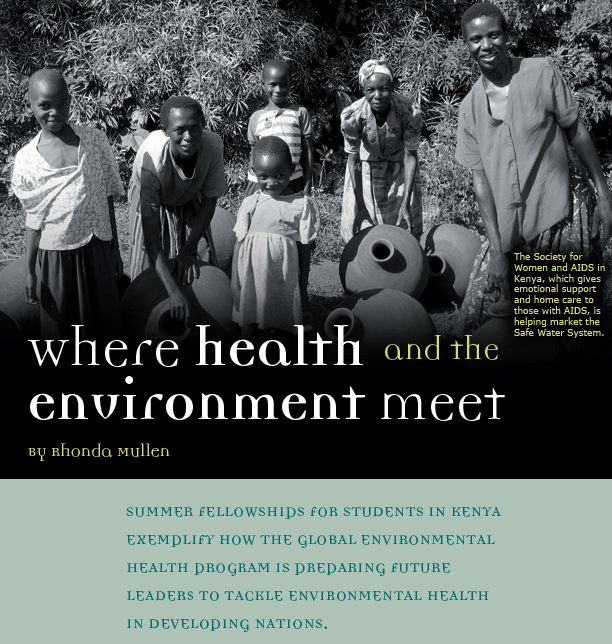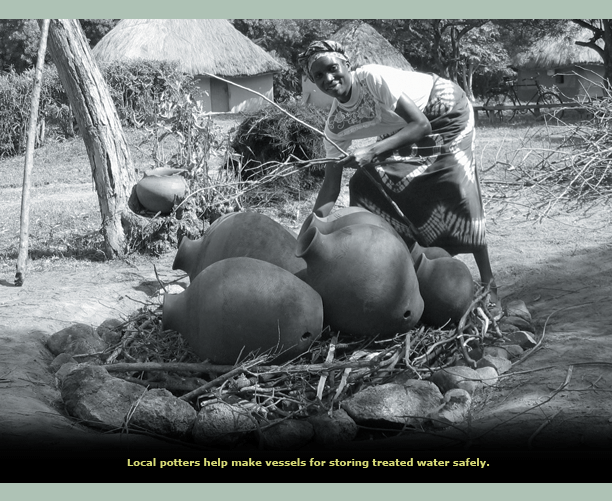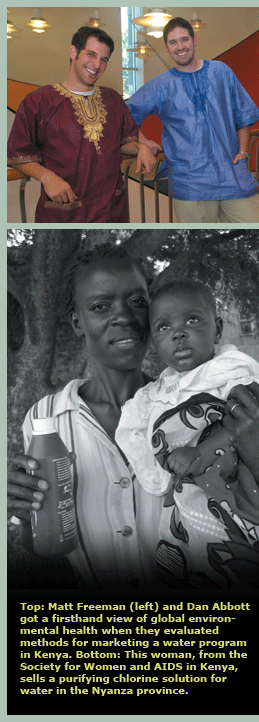













|
 |
 |
 the
AVON ladies of Kenya, but their wares are far from beauty products.
Instead they sell lifesaving interventions: a chlorine solution
to disinfect water, mosquito nets, condoms. They go door-to-door
or sometimes set up simple shops. They are drawn from the Society
for Women and AIDS in Kenya (SWAK), and these women give emotional
support and home care to those with AIDS and the widows and orphans
left in its wake. the
AVON ladies of Kenya, but their wares are far from beauty products.
Instead they sell lifesaving interventions: a chlorine solution
to disinfect water, mosquito nets, condoms. They go door-to-door
or sometimes set up simple shops. They are drawn from the Society
for Women and AIDS in Kenya (SWAK), and these women give emotional
support and home care to those with AIDS and the widows and orphans
left in its wake.
When CDC went looking for a way to
market a safe water intervention in Kenya, it found an untapped
resource in SWAK. The Safe Water System (SWS) combines treatment
of contaminated water with a chlorine solution, safe storage, and
follow-up education. (See related story,
Safer Water) CDC wanted to get the SWS intervention
to the peri-urban communities and remote villages that needed it
the most. How to reach the poorest of the poor in one of the poorest
countries in the world? How to reach those with the worst health
outcomes, the worst sanitation practices, collecting the most polluted
water from the farthest distance?
CDC staff conceived of engaging local
women to sell the purifying chlorine solution. CARE provided the
initial training and products, and the SWAK marketers were in business.
With access to start-up capital from a Kenyan micro-credit organization,
they bought the products wholesale and sold them retail. They started
small, selling the chlorine solution to neighbors, then slowly expanded
their product line to include protein-fortified flour, mosquito
repellent, ointments for HIV sores, condoms, and other health items.
“Empowering women may be the
way to go,” says CDC scientist Rob Quick, who helped developed
the SWS. “We want to make them the most effective Avon ladies
they can be.”
That’s where the Center for
Global Safe Water (CGSW) and the Global Environmental Health (GEH)
program at the Rollins School of Public Health (RSPH) come in. Faculty
and students at the school have helped in the evaluation of the
Safe Water System implementation in Kenya. For example, in the summer
of 2003, RSPH student Shelly Bratton traveled to the shores of Lake
Victoria to compare different strategies in changing water treatment
and storage behaviors. Of various community groups and nongovernmental
organizations promoting the initiative, the highest adoption of
the SWS resulted from the efforts of the SWAK marketer, according
to the evaluation. |
 |
 |
 |
This
summer, fellow GEH students Matthew Freeman and Dan Abbott followed
Bratton’s path to Kenya to do further studies on water behaviors
there. Freeman, working in the western Nyanza area, found SWAK’s
influence was leading to high adoption rates (up to 40% in some
cases) of the chlorine solution in communities they targeted. “These
groups are targeting areas that wouldn’t otherwise be reached
by large-scale social marketing, due to their distance from commercial
centers and low economic status,” Freeman says. “Through
SWAK, the community members take the initiative and become involved
in raising awareness, as opposed to outsiders who may not fully
understand local issues and perceptions.”
Abbott carried out his research further
south in five communities near Homa Bay. During the three months
he lived there, he coordinated a survey, administered in the Luo
language by native interviewers, of 540 households in these five
communities.
Abbott found the distribution system
for the chlorine solution around Homa Bay varied, including two
communities where CARE had trained groups of marketers, one community
where volunteers from a local organization distributed the product,
and two areas where there were commercial advertisements but no
distributors. For Abbott, one surprising finding was that areas
with advertising through radio and wallboards showed a higher recognition
and uptake of the water products than the areas where an active
distribution system was under way. Although Abbott and Freeman had
not completed final analysis of their data at the time of publication,
their preliminary analysis showed that rates of adoption of the
chlorine solution were lower in Abbott’s study group than
in the communities covered by SWAK.
As Abbott’s and Freeman’s
research projects demonstrate, the GEH program teaches skills to
strengthen public health interventions through applied research,
says Richard Rheingans, GEH director and acting director of the CGSW. “We want to raise the bar in
scientific research, and field experience is so important for that.”
acting director of the CGSW. “We want to raise the bar in
scientific research, and field experience is so important for that.”
The GEH masters degree is a new offering
at the RSPH. It began in 2002 and graduated its first full class
in the spring of 2004. In fact, it is one of only a few programs
in the country that formally links the environment with international
studies in a degree program. In addition to solid practicum and
field experience, the program offers a grounding of classroom instruction
in international health studies and the environment.
“The GEH program is a wonderful
educational opportunity, combining the vital subject matter of environmental
health—safe water, clean air, toxin reductions, healthy urban
design—with the global orientation and the on-the-ground program
skills of inter-national health,” says Howard Frumkin, chair
of the Department of Environmental and Occupational Health (EOH).
GEH faculty are drawn from the departments
of International Health and EOH and include guest lecturers from
public health partners. Neither department could have offered such
a program alone, says International Health Chair Reynaldo Martorell,
but “by pooling our resources and working with our partners
at CDC and CARE, we are able to offer quality MPH training and incredible
opportunities for summer field research.” Reflecting the growing
program, EOH has added four new faculty this year.
The program arose from a natural intersection
of international and environmental health. “Increasingly the
world’s most serious environmental problems are found in developing
nations, and projected trends in population growth and industrialization
suggest that this will remain true for many years,” Frumkin
says. “GEH graduates are well positioned to help protect public
health around the world by recognizing, assessing, and controlling
environmental hazards.”
For Dan Abbott, the program is setting
the stage for a future career. With ready access to expert faculty
at RSPH and CDC, a field experience under his belt, and work experiences
at The Carter Center and the Center for Global Safe Water this fall,
he has plans to continue in international and environmental health
work after graduation—“much along the lines of what
I’ve done this summer,” he says.
Freeman is interning at CARE USA this
fall. “The program’s ties to CDC got me to Kenya and
now to CARE in Atlanta,” says Freeman. “Nowhere else
could I have this opportunity.”
For
more about the GEH program, visit
www.sph.emory.edu/GLOBAL/index.html |
 |
| |
|
|
| |
|
|
|
|
|
|
|



